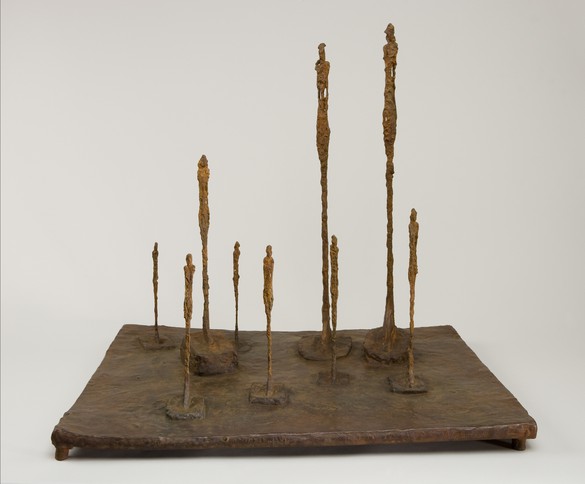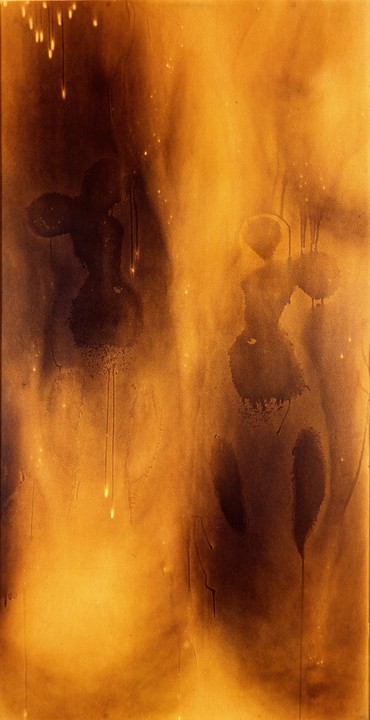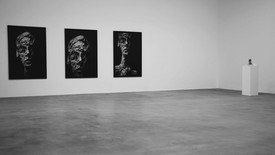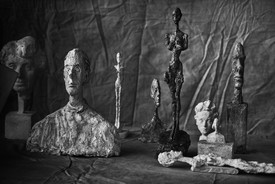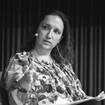
Alison McDonald is the Chief Creative Officer at Gagosian and has overseen marketing and publications at the gallery since 2002. During her tenure she has worked closely with Larry Gagosian to shape every aspect of the gallery’s extensive publishing program and has personally overseen more than five hundred books dedicated to the gallery’s artists. In 2020, McDonald was included in the Observer’s Arts Power 50.
ALISON MCDONALDIn the late 1950s and early 1960s, Alberto Giacometti and Yves Klein both had studios in Montparnasse, a short distance from one another. Of course these two artists were from different generations and their work is dramatically different. How did the idea of bringing these two artists together begin, and how did it evolve?
JOACHIM PISSARROParis after the war was a vibrant and culturally complex place, with the studios and cafés of Montparnasse and Saint-Germain-des-Prés home to an artistic scene of seemingly limitless vitality. André Malraux was the minister of culture [1959–69], and the artists and writers in this world, like Klein and Giacometti, were grappling with the cultural inheritance of France and the daunting task of reinventing a culture after the utter devastation of World War II. Giacometti and Klein lived at this particular crux in history, and embraced the daunting challenges they faced with distinct plastic solutions to this haunting moment. They truly embody the unstoppable creative force of the time, although from very different artistic approaches.
A few years ago, we started discussing the potential for an exhibition that would put these two postwar artists in dialogue with each other; I found the relationships and contrasts between them tantalizing. As the project evolved, it became obvious that there were far greater connections between them than we ever thought. Most histories of modernism classify them as figures of separate artistic eras, and by the late 1950s, Giacometti was the reigning king of Montparnasse, an unparalleled master—a kind of lonesome superstar, recognizable to all—while the much younger Klein was still starting out as a prophet of the new, with his quasi-conceptual approach to art, and immaterialist philosophy. But this is only part of the story. When the art is placed in conjunction, we can see deep resonances and connections, both visual and intellectual.
AMcdWith the support of Fondation Giacometti and Yves Klein Archives, you have planned quite an austere presentation for the exhibition and a far more immersive experience for the accompanying publication.
JPYes. It’s important that these works be given space to breathe. The works by each artist are powerful, and the viewer must be able to confront them without distraction or mediation. The Grosvenor Hill gallery, in London, is a superb new space, designed by Caruso St John, and its wide, spare, generously open design offers the perfect envelope for this dialogue: the immediacy and visual richness of their lyrical austerity and elegance, and above all, the uncanny visual correspondences between Giacometti and Klein’s figurative works. For these artists, with works of such vital presence, a spare presentation is actually more immersive.
On the other hand, the publication allows the audience a window into the life of each artist. The book is immersive in that it presents the richness of influences, historical context, and sources of inspiration.
AMcdBoth artists were actively engaged with intellectuals and philosophers.
JPGiacometti seems unmatched in terms of catalyzing literary and philosophical responses, with Sartre, de Beauvoir, Merleau-Ponty, Jean Genet, and others—all close friends of Giacometti’s—responding deeply and beautifully to his work. It is also noteworthy that a surprising number of poets have written about Giacometti. His work seems to have invited a kind of transdisciplinary dialogue. Francis Ponge, Michel Leiris, Jacques Dupin, Yves Bonnefoy—all have produced some of the most evocative and awe-inspiring interpretations of Giacometti’s sculptural work, even the recent Nobel Prize–winner Patrick Modiano seems to open one of his more recent books with a scene based on a key moment in Giacometti’s life. There are also the studio memoirs by David Sylvester, James Lord—and Isaku Yanaihara, a translator of many key texts of existentialism, was Giacometti’s model for more than two hundred sittings. The catalogue has an excerpt from Yanaihara’s memoir, which will be translated for the first time.
Klein was a writer himself, and his writings are essential and often very beautiful in understanding the conceptual underpinnings of his work. He was also deeply inspired by literary works, which played a major role in the formation of his philosophy and ideas—Gaston Bachelard and Mallarmé. Klein died quite young, yet there is still quite a depth of material about his work as well. The catalogue will present extraordinary photographs that capture Klein’s unique creative process, including documentation of one of his Anthropometry performances and the creation of works from his Fire painting series. These rarely seen photos convey powerfully the atmosphere of his revolutionary performances.
AMcdWhat works do you consider highlights of the exhibition?
JPThe anthropometry works will echo nicely with the reductions and repetitions of Giacometti’s Femme de Venise [1958]. Or the Klein sponges have fantastic visual resonances with a Tête sur tige [1947], a smaller sculpture by Giacometti. The highlight will be bringing the works together—these universes, so self-contained, defamiliarizing, orbiting each other. How will Klein’s potent, high-voltage blue look when it shares a space with Giacometti’s intense figures? That’s what I’m most excited to see.
AMcdHow do you feel each artist was unique in their approach to the figure, or even, specifically, to the female figure?
JPBoth artists were moving ahead while looking back breaking new ground in the figurative mode while mining the past for prototypical, archetypal forms. The female forms by both artists have the aura and dignity of primeval goddesses. They were both fascinated by Egyptian art and revered the prehistoric cave paintings at Lascaux, which turn up as clear visual echoes in their works. Both artists were interested in concepts surrounding metaphysical and transcendental ideas; both of them appeared to evolve within this realm of pure primordial creation: noble, dignified, and erotic.
AMcdOne interesting overlapping theme is about “reduction.” Perhaps you could speak about how you feel this will be evident in the exhibition?
JPKlein is probably most famous for reducing his palette to one color, International Klein Blue. Giacometti is famous for his emaciated, abbreviated figures, with bodies reduced to their graceful minimum. Particular features are absent; it is humanity, remote and unmasked, in its purest form.
AMcdBoth artists are responding in some way to the wars of their time. How do you feel acts of war and violence influence or inform their art making?
JPThey were both avowedly apolitical, but it is hard not to give the works a political reading after the devastation of the world wars. The catastrophes are tangible even if the artists were turning away from them and their evil: Klein toward spirituality and immateriality, Giacometti toward an extreme phenomenology that broke with everyday perception.
Still, both artists, rather than creating something that reflected the chaos or drama, chose to rise above it, transforming and disciplining it into elegant, lyrical, austere matter. The signs of anguish and history are buried in the works.
AMcdThis is a quite special and unique collaboration with both Fondation Giacometti and Yves Klein Archives. How has that support, including access to extensive documentation, helped shape all aspects of this project?
JPYves Klein Archives and Fondation Giacometti have been incredibly generous in helping us put this project together. The thoroughness of their archives has allowed exceptional depth to our research, and we are indebted that their preparedness and dedication to scholarship has greatly benefited our project since its gestation. We have had a chance to see rare historical information, and we are very grateful for their generosity.
Alberto Giacometti Yves Klein: In Search of the Absolute, Gagosian Gallery Grosvenor Hill, London, April 27–June 11, 2016.
